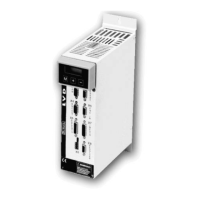Parker Hannifin S.p.A. - Divisione S.B.C. LVD User’s Manual
82
6 CAN BUS
The LVD drive is equipped with a CanBus interface based on Physical layer
ISO/DIS11898, the Data link layer is the full CAN version 2.0 part A (ID 11bit) and a subset
of the application layer SBCCAN is utilised.
Hardware connection
MASTER
CanBus
X2
NODE 1
2
7
5
6
CANL
CANH
120
X2
NODE "n"
2
7
5
6
X2
FINAL NODE
2
7
5
6
120
There are two CanBus operating modes on the LVD drive.
The first, designated real time mode, enables a real time digital link between 15 LVDs and
a control that performs the calculation of trajectories and transmits the position reference, the
speed reference, or both references to the LVDs, which can respond with the current position
of the motors (b70.2=1). Real time mode is automatically assumed when Pr31=15 and
b70.3=1. Transmission rate in real time mode is 1Mbps if b70.4=0 or 500kbps if b70.4=1; the
maximum bus length is 40m at 1Mbps or 100m at 500kbps.
The second mode, communication mode, makes it possible to write or read each
parameter of each LVD connected to the bus (maximum 15); this facility is invaluable when
using the motion functions already implemented in the LVD drive basic software.
Communication mode is automatically assumed when Pr31≠15 or when Pr31=15 and
b70.3=0; the transmission rate is 125kbps and maximum bus length, in this case, is 500m.
The changes of transmission rate, address or mode are activated by the command b42.3 or
at the next power on.
The drive address assignment could be automatically done following this procedure:
- connect the drives via serial link and power them on disabled
- set the binary code of the desired serial address for each drive using digital inputs 3, 4, 5
and 6; so you have 16 codes at disposal, digital input 3 is the least significant bit
- send the broadcast message to set the byte at the address 0x9C equal to 128
In this way each drive having Pr27=0 (default) set Pr27 equal to the code at its digital inputs,
set b40.14=1 and initialise the serial communication.

